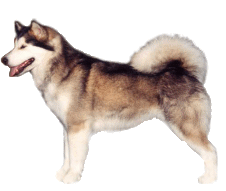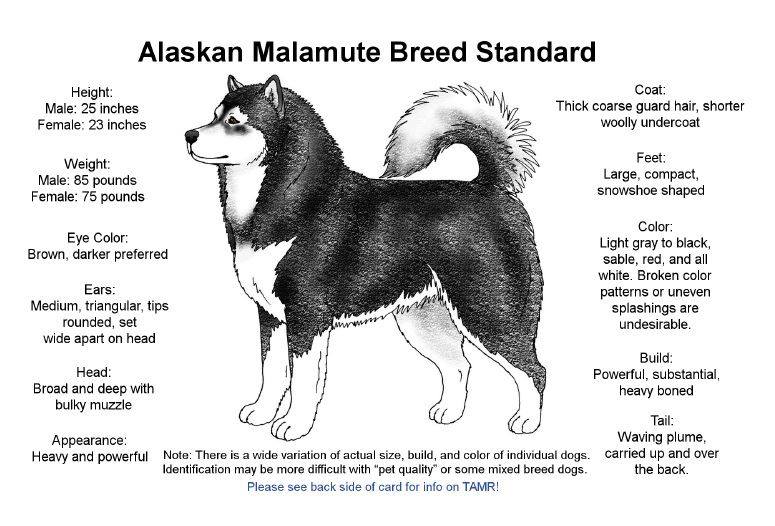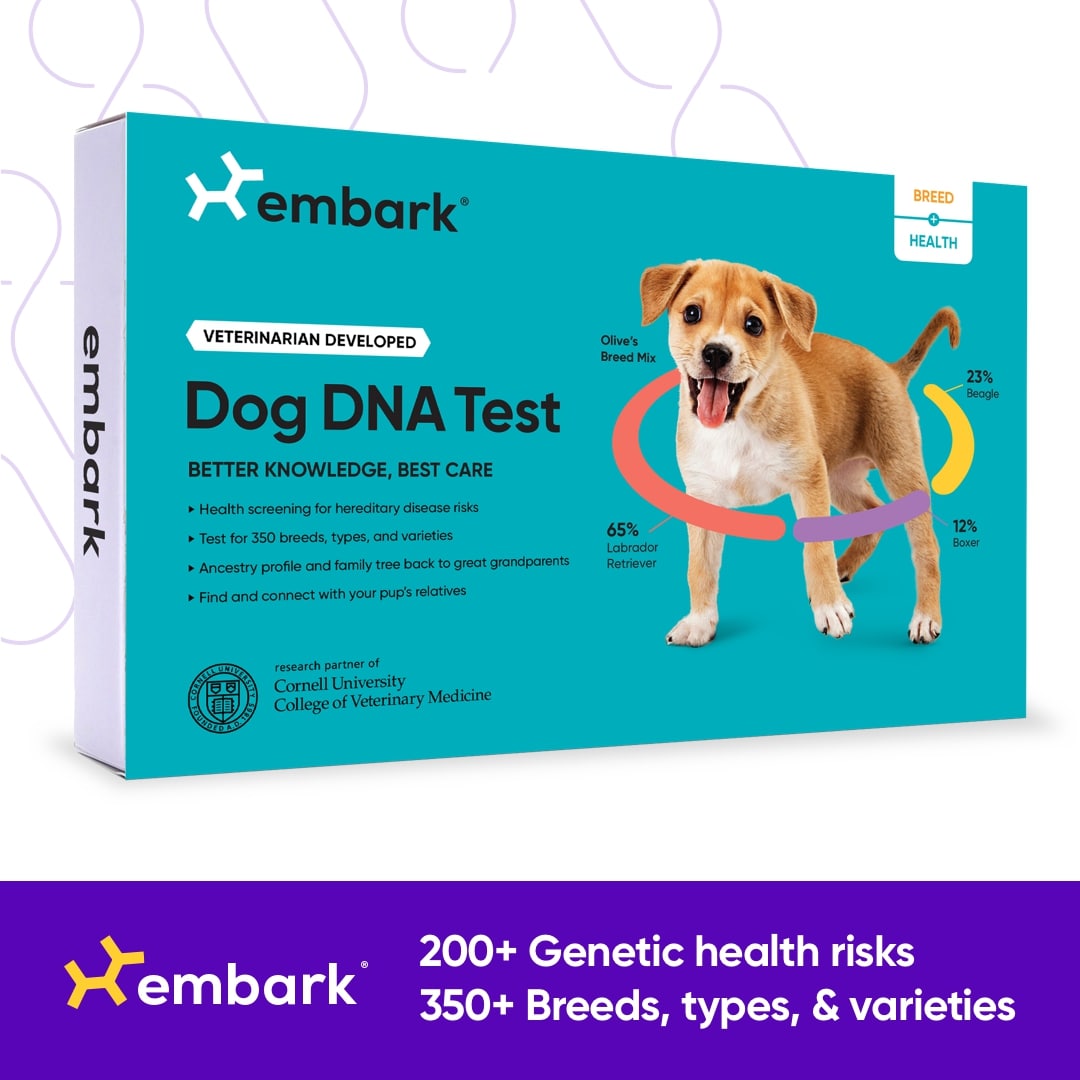Interpretation of the Breed Standard
(What is a Breed Standard?)

The "Breed Standard" is a written description of a purebred dog breed (in this case Alaskan Malamutes) as described and agreed to by the membership of the national Alaskan Malamute Club of America (AMCA) and approved by the American Kennel Club (AKC). It is an exact written description of the physical characteristics, temperament, and working ability the Alaskan Malamute should have. Because it is a written description, and not a photograph or picture, it is open to individual interpretation as to what "moderate" or "gently sloping" means, for example. Also, in the Malamute standard, various mask markings, colors and "types" of Malamute are allowed, including some variation in size. At American Kennel Club dog shows, judges are supposed to judge using the standard as a representation of the perfect dog and compare every dog in the ring to this written guideline. When a breeder produces dogs "within the standard" it means he is striving to produce a dog as close as possible to the perfect dog outlined in it. He is not trying to produced dogs that are much larger or smaller, taller or shorter, with lighter eyes or flatter feet than the standard calls for (although he certainly may get them anyway). The standard is a goal reputable breeders are strive to attain. The "perfect" Alaskan Malamute doesn't exist.
The first standard written 4/17/1935 says the height of a male dog should average from 22 to 25 inches. The Bitch should be from 20 to 23 inches, male dogs averaging from 65 to 85. Bitch averaging from 50 to 70 pounds. If you haven't noticed...they tend to be a LOT bigger now and even the new standard does not cite a "range" but an actual "size" which is disappointing since any musher will tell you the smaller dogs, pound for pound are more efficient and pull more weight for their size. It's also nice to be able to haul less food....
The most important influence on the Alaskan Malamute's development were climate and food resources. Every characteristic he exhibits reflects this environment. The climate dictated he develop a thick, warm double coat. The scarcity of game meant he had to have a totally efficient metabolism. An efficient metabolism allowed these dogs to have the energy to work, day after day, for long hours on little food. Alaskan Malamutes evolved through survival of the fittest and every part of their body evolved to reflect the highest efficiency in a harsh, extreme environment. Over time the standard has changed slightly, but correct structure is generally outlined as follows. We are not allowed to print the exact standard here for copyright reasons. An exact copy can be obtained from the Alaskan Malamute Club of America:
- A powerful, substantially built dog with a deep chest and strong, compact body.
- A thick, coarse guard coat and dense woolly undercoat that is 1-2" in depth when the dog is in full coat. A coat that is too long or too soft is unacceptable.
- The head is broad, ears wedge shaped and erect when alerted.
- The muzzle is bulky, but not pointed or long or short and stubby. The skull should be broad between the ears, flattening on top as it reaches the eyes. The cheeks should be moderately flat and a slight furrow between the eyes, with little "stop" (the line where the top of the forehead blends down to the muzzle between the eyes).
- Face markings are a distinguishing feature with a cap over the head and the rest of the face being white or cream; or the face is marked with the appearance of a mask - markings under eyes, around eyes, down the nose or various combinations of these.
- Malamutes can be various colors, but are usually some combination of gray, black, sable or red with white. All white is acceptable too. Mantelling, a nape spot, or a blaze on the forehead and the various cap/mask markings are all acceptable. Color should never be spotted or in uneven splashes over the body, however.
- A Malamute has a compact foot, well furred with thick pads. It's front legs are straight with big bone. Hind legs are broad and powerful. The back is straight, gently sloping from the shoulders to the hips.
- Intelligent expression is seen in the almond shaped eye, the darker brown the better. Blue eyes are a serious fault. The nose, lips and eye rims should be black (except in red dogs and a "snow nose" is acceptable - slight pink streaking in winter).
- Malamutes should be friendly, affectionate and loyal. Devoted companions, they will be playful on invitation, but with a certain dignity after they are mature. After all, they are the King of Dogs!
- Lips are tight fitting (no drooping lips or eyelids), a correct bite fits together tightly with the top teeth fitting tightly in front of the lower incisors. Ears are medium size, but small in proportion to the head and should not be set too high or low.
- The neck and shoulders should be strong and moderately arched.
- Steady, balanced, tireless movement is of utmost importance as well as strength and endurance. A long loin and excess weight are not acceptable.
- The standard calls for moderate angles on all joints, and for the dog to move true.
- Dew claws on hind legs should be removed (if there at birth, most Malamutes are born without them).
- The tail should be well furred and carried high over the back when relaxed. It shouldn't be tightly curled (like an Akita), or short furred and carried like a fox brush. It should look like a waving plume...
- There is a natural size range in the breed, but desirable sizes are: 25 inches/85 lbs. for males and 23 inches at the shoulder and 75 lbs. for females. Although size should never outweigh proportion, type or soundness.
The Alaskan Malamute standard was established through study and consideration. It is through the breed standard document that breeders try to maintain the breed to be the dog it originally was meant to be.Good or bad bad, however, over time we are seeing changes. Malamutes are getting bigger, gentler, less dog aggressive than they used to be. Many are bred solely for the show ring or Malamute market with no thought to working ability. The the strong-willed, exuberant dog with need to work is difficult to live with in a typical household. On the other hand, if the dog becomes too soft it can't hunt or doesn't have the desire to pull that it should. It remains to be seen how these slow modifications over time will affect the breed as a whole in the future.

Introduction to Reproduction and GeneticsBy the end of this course, you will be able to define key terms used in genetics, draw genetic diagrams, and explain how genes can be manipulated for beneficial purposes. You will also be able to compare plant reproduction to human reproduction. There are a number examination type of questions that are presented in this course, along with their suggested answers. For anyone who wants to learn how genes are inherited.










